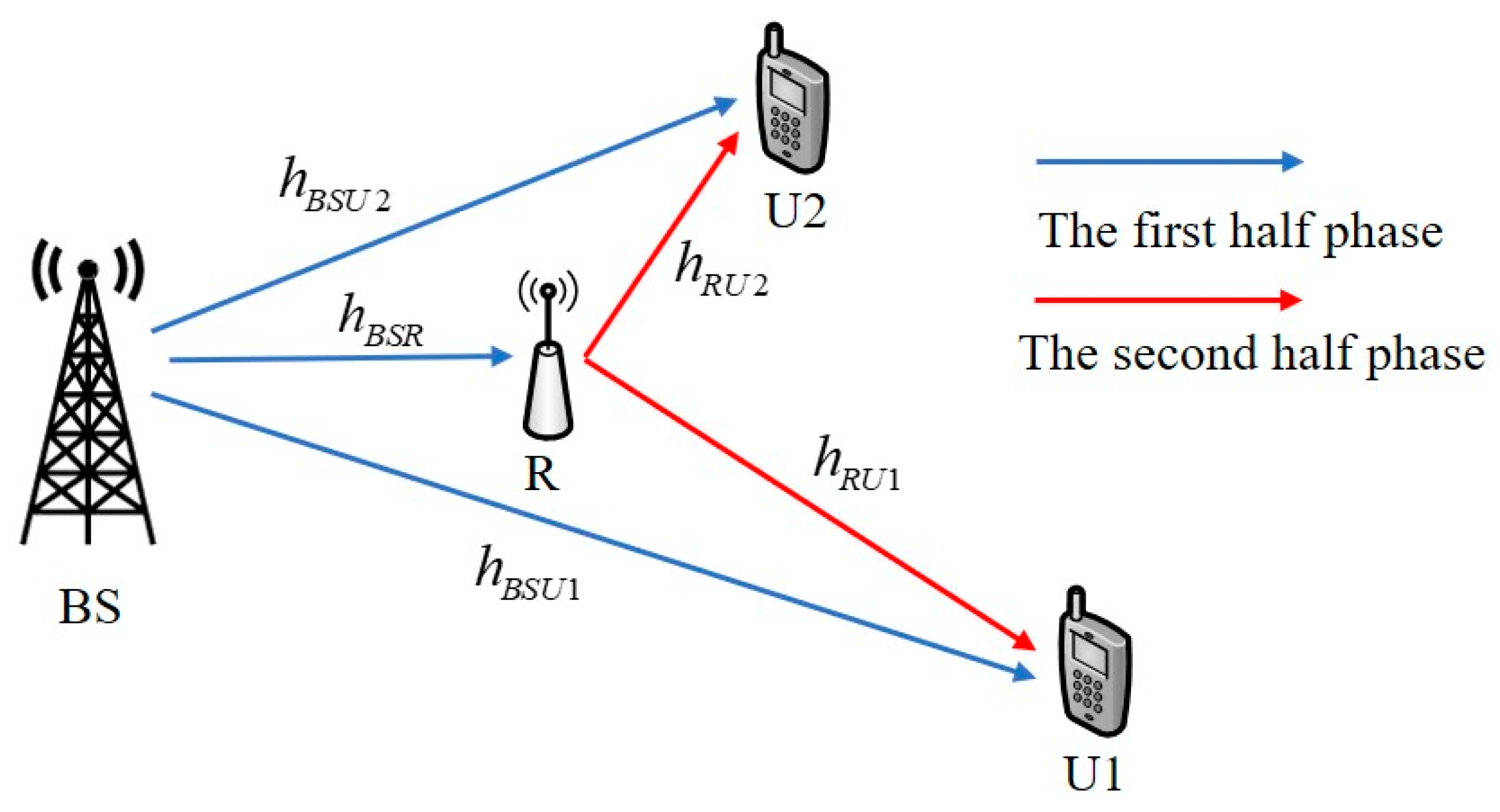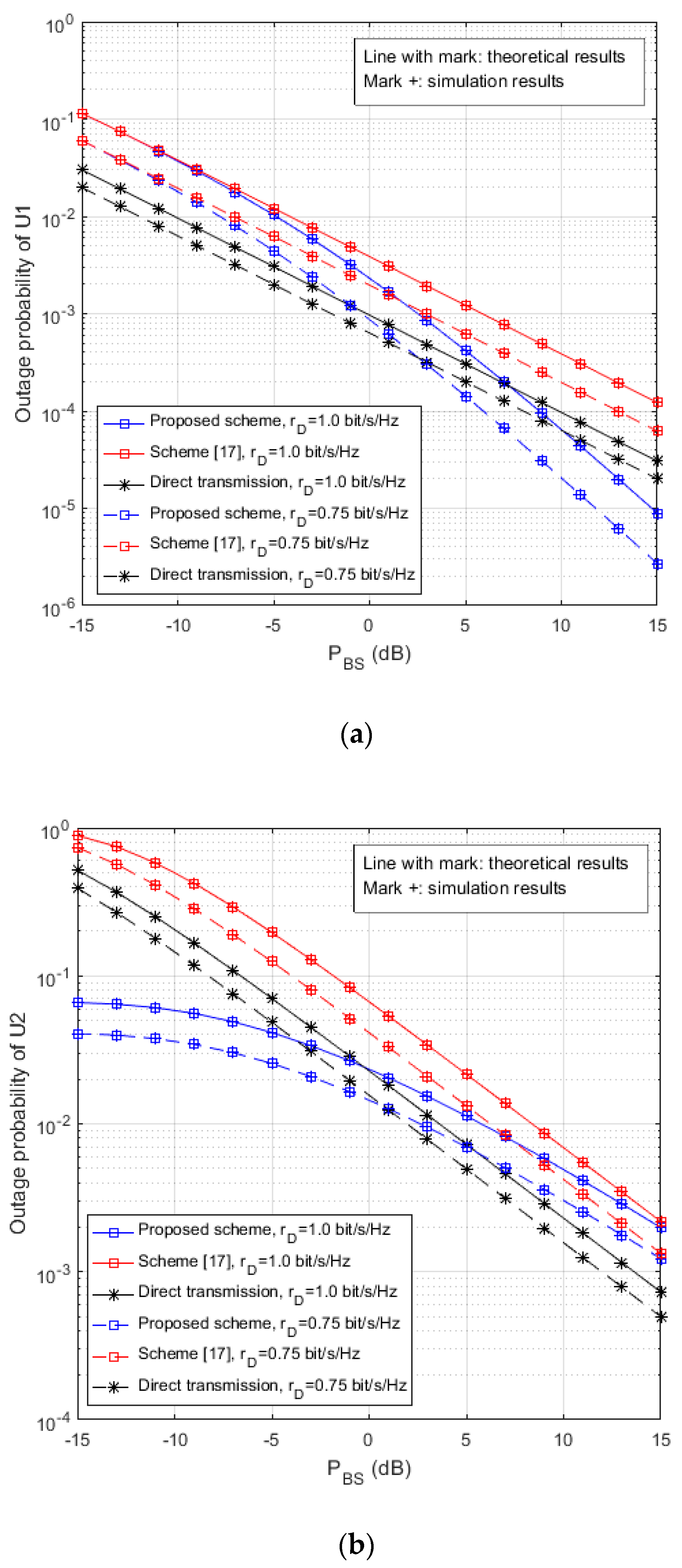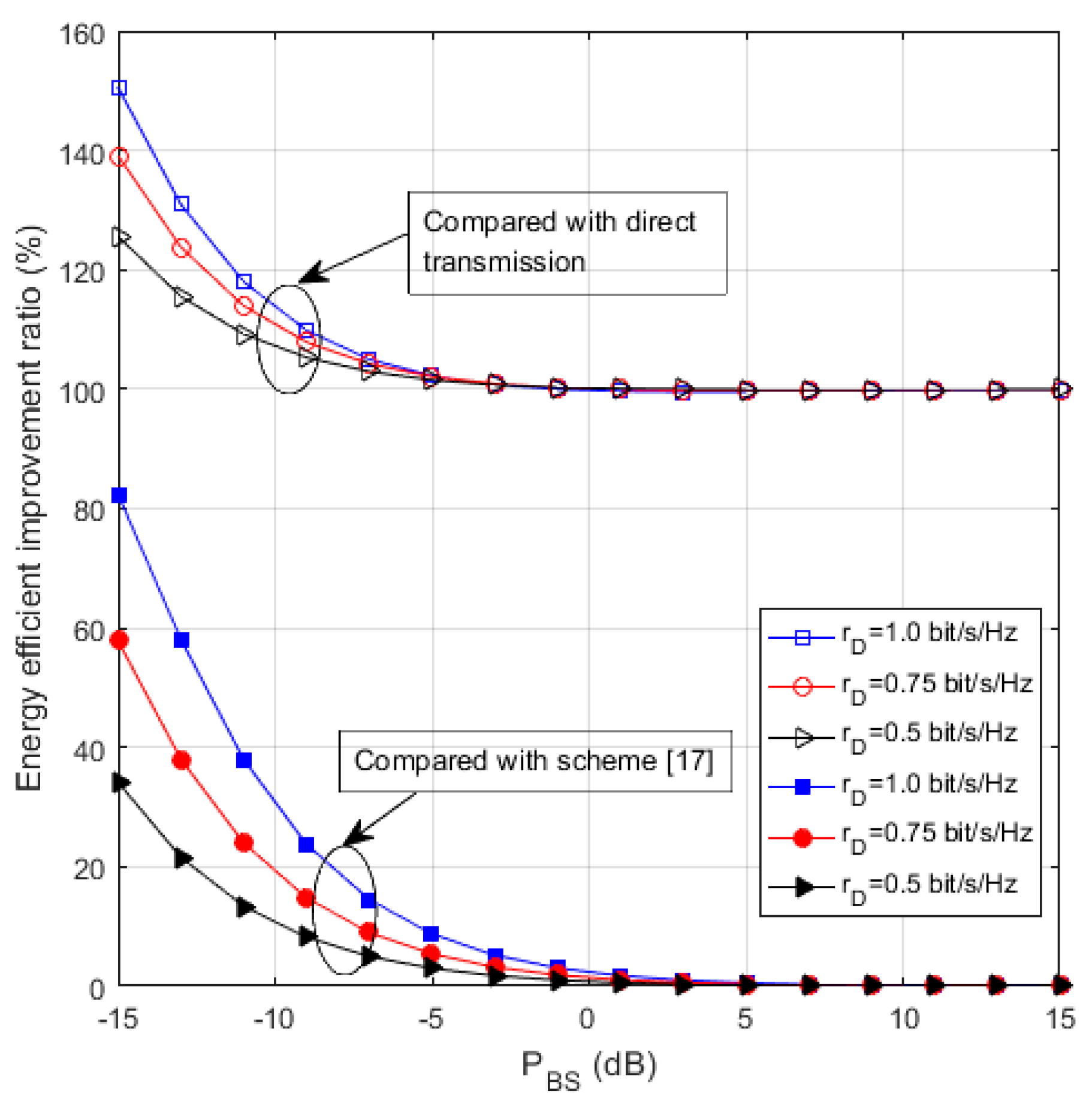Outage Analysis of Relay-Assisted NOMA in Cooperative Cognitive Radio Networks with SWIPT
Abstract
:1. Introduction
- We develop a wireless energy harvesting and signal transmission protocol for the considered non-orthogonal multiple access (NOMA) scheme in cognitive radio networks. In particular, the whole transmission block is divided into two phases. During the first phase, the base station (BS) transmits a superposed signal to receivers while the relay node harvests energy and obtains data from the received signal. In the second phase, the relay node forwards the BS’s signals by using the harvested energy.
- The exact expressions for the outage probabilities of both the receivers are derived and the analytical results are validated through Monte Carlo simulations, which verifies the correctness of our analyses.
- By considering the maximization of the average EE under the required transmission rates, we propose a full-search algorithm to obtain the optimal power allocation and proportion of information splitting coefficients, which provides a practical guideline that the optimized coefficients enable the proposed protocol to achieve a better performance of EE compared with other scheme and direct transmission.
2. System Model
3. Outage Performance and Parameter Optimization
3.1. Outage Probability Analysis
- if
- if
- ifThe derived result of is omitted because it is similar to Proposition 1.
3.2. Parameters Joint Optimization
| Algorithm 1 Parameters Joint Optimization |
| Define and as the step size for and , respectively, and Initialize . |
| 1: for the given , do S1–S3 |
| 2: S1: for the given , then calculate |
| 3: if , then calculate |
| 4: if , then , , and |
| 5: update |
| 6: else keep the original parameter values |
| 7: end if |
| 8: end if |
| 9: end for |
| 10: S2: update |
| 11: end for |
| 12: S3: update |
| 13: Choose the globally optimal solution from the following equation |
4. Numerical Results
5. Conclusions
Author Contributions
Funding
Conflicts of Interest
Appendix A
- if or
- if
References
- Luo, S.; Teh, K.C. Adaptive Transmission for Cooperative NOMA System with Buffer-Aided Relaying. IEEE Commun. Lett. 2017, 4, 937–940. [Google Scholar] [CrossRef]
- Qin, Z.; Yue, X.; Liu, Y.; Ding, Z.; Nallanathan, A. User Association and Resource Allocation in Unified NOMA Enabled Heterogeneous Ultra-Dense Networks. IEEE Commun. Mag. 2018, 56, 86–92. [Google Scholar] [CrossRef] [Green Version]
- Zhang, J.; Tao, X.; Wu, H.; Zhang, X. Performance Analysis of Users Pairing in Cooperative NOMA Networks. IEEE Access 2018, 6, 74288–74302. [Google Scholar] [CrossRef]
- Zhai, C.; Zhang, W.; Mao, G. Cooperative Spectrum Sharing Between Cellular and Ad-Hoc Networks. IEEE Trans. Wirel. Commun. 2014, 13, 4025–4037. [Google Scholar] [CrossRef]
- Liang, W.; Ng, S.X.; Hanzo, L. Cooperative Overlay Spectrum Access in Cognitive Radio Networks. IEEE Commun. Surv. Tutor. 2017, 19, 1924–1944. [Google Scholar] [CrossRef]
- Zhang, H.; Guo, Y.X.; Zhong, Z.; Wu, W. Cooperative Integration of RF Energy Harvesting and Dedicated WPT for Wireless Sensor Networks. IEEE Microw. Wirel. Compon. Lett. 2019, 29, 291–293. [Google Scholar] [CrossRef]
- Liu, Z.; Lu, G.; Ye, Y.; Shi, L. On the Performance of Battery-Assisted PS-SWIPT Enabled DF Relaying. Information 2020, 11, 165. [Google Scholar] [CrossRef] [Green Version]
- Lv, L.; Chen, J.; Ni, Q. Cooperative Non-Orthogonal Multiple Access in Cognitive Radio. IEEE Commun. Lett. 2016, 20, 2059–2062. [Google Scholar] [CrossRef] [Green Version]
- Xu, W.; Li, X.; Lee, C.H.; Pan, M.; Feng, Z. Joint Sensing Duration Adaption, User Matching, and Power Allocation for Cognitive OFDM-NOMA Systems. IEEE Trans. Wirel. Commun. 2018, 17, 1269–1282. [Google Scholar] [CrossRef]
- Arzykulov, S.; Nauryzbayev, G.; Tsiftsis, T.A.; Maham, B. Performance Analysis of Underlay Cognitive Nonorthogonal Multiple Access Networks. IEEE Trans. Veh. Technol. 2019, 68, 9318–9322. [Google Scholar] [CrossRef]
- Li, B.; Qi, X.; Huang, K.; Fei, Z.; Zhou, F.; Hu, Q. Security-Reliability Tradeoff Analysis for Cooperative NOMA in Cognitive Radio Networks. IEEE Commun. Lett. 2019, 67, 83–96. [Google Scholar] [CrossRef]
- Hedayati, M.; Kim, I.-M. On the Performance of NOMA in the Two-User SWIPT System. IEEE Trans. Veh. Technol. 2018, 67, 11258–11263. [Google Scholar] [CrossRef]
- Xu, Y.; Shen, C.; Ding, Z.; Sun, X.; Yan, S.; Zhu, G.; Zhong, Z. Joint Beamforming and Power-Splitting Control in Downlink Cooperative SWIPT NOMA Systems. IEEE Trans. Signal Process. 2017, 65, 4874–4886. [Google Scholar] [CrossRef] [Green Version]
- Bariah, L.; Muhaidat, S.; A-Dweik, A. Error Probability Analysis of NOMA-based Relay Networks with SWIPT. IEEE Commun. Lett. 2019, 23, 1223–1226. [Google Scholar] [CrossRef]
- Zhang, Y.; Yang, Q.; Zheng, T.X.; Wang, H.; Ju, Y.; Meng, Y. Energy Efficiency Optimization in Cognitive Radio Inspired Non-Orthogonal Multiple Access. In Proceedings of the IEEE 27th International Symposium on Personal, Indoor and Mobile Radio Communications PIMRC, Valencia, Spain, 4–8 September 2016. [Google Scholar]
- Wang, X.; Na, Z.; Lam, K.Y.; Liu, X.; Wang, L. Energy Efficiency Optimization for NOMA-based Cognitive Radio with Energy Harvesting. IEEE Access 2019, 7, 139172–139180. [Google Scholar] [CrossRef]
- Yu, Y.; Yang, Z.; Wu, Y.; Hussein, J.A.; Jia, W.K.; Dong, Z. Outage Performance of NOMA in Cooperative Cognitive Radio Networks with SWIPT. IEEE Access 2019, 7, 117308–117317. [Google Scholar] [CrossRef]
- Tang, K.; Shi, R.; Dong, J. Throughput Analysis of Cognitive Wireless Acoustic Sensor Networks with Energy Harvesting. Future Gener. Comput. Syst. 2018, 86, 1218–1227. [Google Scholar] [CrossRef]
- Zhai, C.; Liu, J.; Zheng, L. Relay-Based Spectrum Sharing with Secondary Users Powered by Wireless Energy Harvesting. IEEE Commun. Lett. 2016, 64, 1875–1887. [Google Scholar]
- Wang, Z.; Chen, Z.; Xia, B.; Luo, L.; Zhou, J. Cognitive Relay Networks with Energy Harvesting and Information Transfer: Design, Analysis, and Optimization. IEEE Trans. Wirel. Commun. 2016, 15, 2562–2576. [Google Scholar] [CrossRef]
- Hieu, T.C.; Cuong, N.L.; Hoang, T.M.; Quan, D.T.; Hiep, P.T. On Outage Probability and Ergodic Rate of Downlink Multi-User Relay Systems with Combination of NOMA, SWIPT, and Beamforming. Sensors 2020, 20, 4737. [Google Scholar] [CrossRef]
- Nguyen, H.V.; Kim, H.M.; Kang, G.M.; Nguyen, K.H.; Bui, V.P.; Shin, O.S. A Survey on Non-Orthogonal Multiple Access: From the Perspective of Spectral Efficiency and Energy Efficiency. Energies 2020, 13, 4160. [Google Scholar] [CrossRef]
- Zhang, Y.; Wang, X.; Wang, D.; Lan, Y.; Zhang, Y. Outage Performance of Relay Sparse Code Multiple Access Networks. In Proceedings of the 2019 IEEE Wireless Communications and Networking Conference (WCNC), Marrakesh, Morocco, 15–18 April 2019; pp. 1–6. [Google Scholar]
- Tseng, S.; Tsai, C.; Yu, C. Outage-Capacity-Based Cross Layer Resource Management for Downlink NOMA-OFDMA Video Communications: Non-Deep Learning and Deep Learning Approaches. IEEE Access 2020, 8, 140097–140107. [Google Scholar] [CrossRef]
- Gradshteyn, I.S.; Ryzhik, I.M. Table of Integrals, Series, and Products, 7th ed.; Academic Press: New York, NY, USA, 2007. [Google Scholar]
- Gorski, J.; Pfeuffer, F.; Klamroth, K. Biconvex Sets and Optimization with Biconvex Functions: A Survey and Extensions. Math. Methods Oper. Res. 2007, 66, 373–407. [Google Scholar] [CrossRef]




Publisher’s Note: MDPI stays neutral with regard to jurisdictional claims in published maps and institutional affiliations. |
© 2020 by the authors. Licensee MDPI, Basel, Switzerland. This article is an open access article distributed under the terms and conditions of the Creative Commons Attribution (CC BY) license (http://creativecommons.org/licenses/by/4.0/).
Share and Cite
Tang, K.; Liao, S. Outage Analysis of Relay-Assisted NOMA in Cooperative Cognitive Radio Networks with SWIPT. Information 2020, 11, 500. https://doi.org/10.3390/info11110500
Tang K, Liao S. Outage Analysis of Relay-Assisted NOMA in Cooperative Cognitive Radio Networks with SWIPT. Information. 2020; 11(11):500. https://doi.org/10.3390/info11110500
Chicago/Turabian StyleTang, Kun, and Shaowei Liao. 2020. "Outage Analysis of Relay-Assisted NOMA in Cooperative Cognitive Radio Networks with SWIPT" Information 11, no. 11: 500. https://doi.org/10.3390/info11110500
APA StyleTang, K., & Liao, S. (2020). Outage Analysis of Relay-Assisted NOMA in Cooperative Cognitive Radio Networks with SWIPT. Information, 11(11), 500. https://doi.org/10.3390/info11110500




